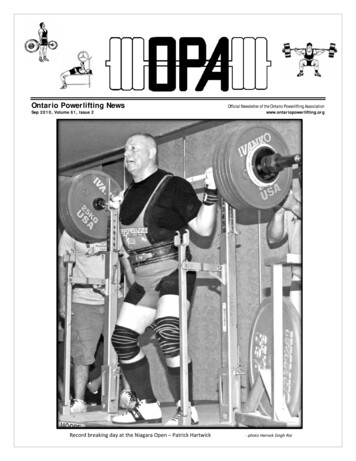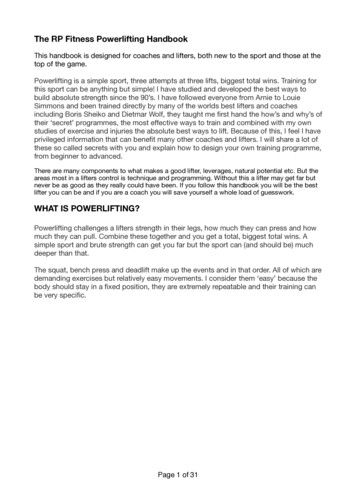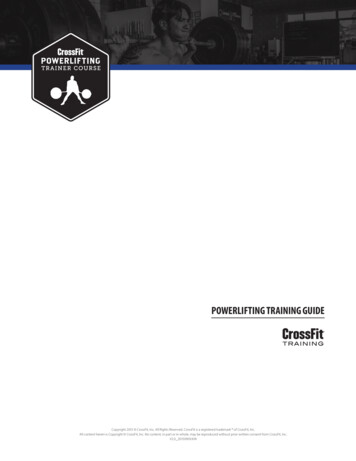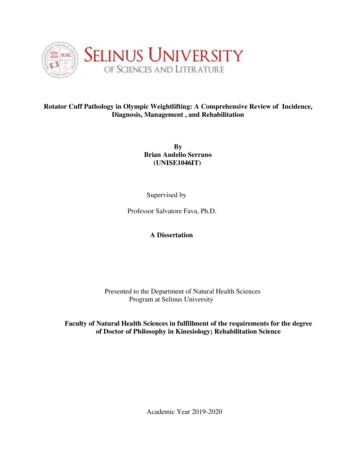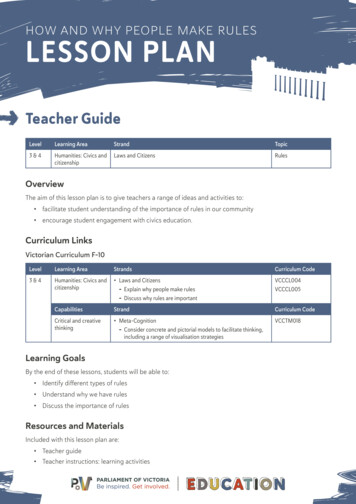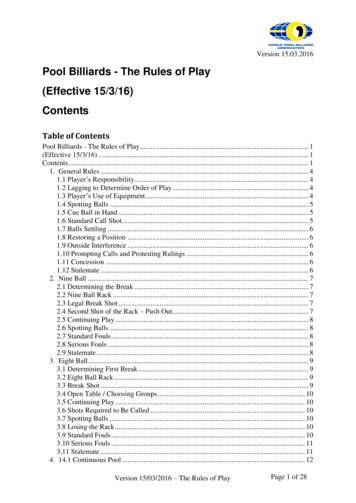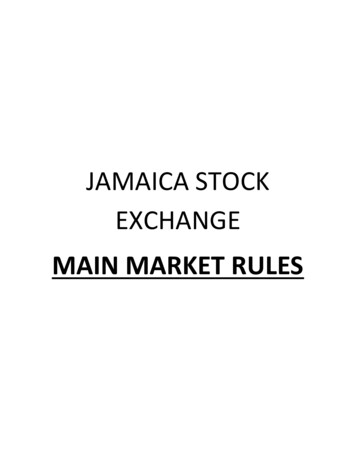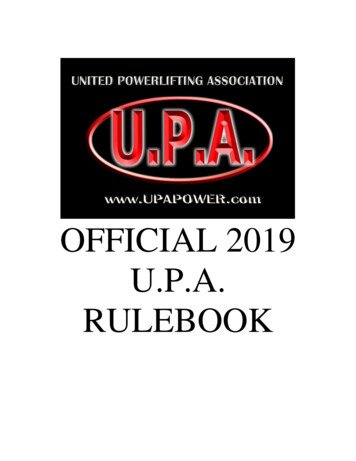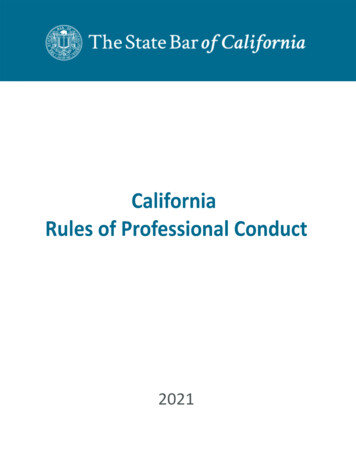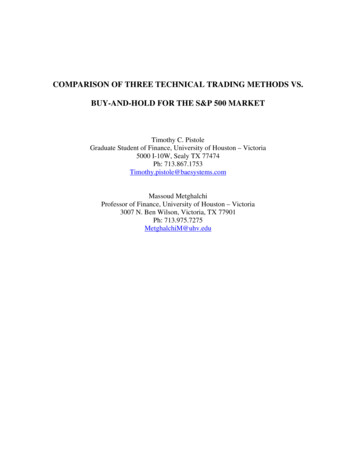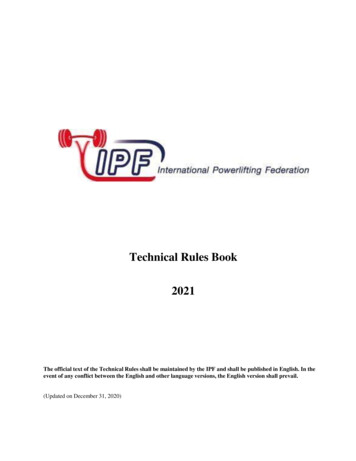
Transcription
Technical Rules Book2021The official text of the Technical Rules shall be maintained by the IPF and shall be published in English. In theevent of any conflict between the English and other language versions, the English version shall prevail.(Updated on December 31, 2020)
Technical Rules book of the International Powerlifting FederationGENERAL RULES OF POWERLIFTING . 2Age Categories . . 2Bodyweight Categories: . . 3EQUIPMENT AND SPECIFICATIONS . 5Scales . 5Platform. . 5Bars and Discs . . 5Collars .6Squat Racks . . 6Bench .6.Clocks. 7Lights . . 7Failure Cards / Paddles. . 7Referees numbered card system - reason for failure. . 7Scoreboard . 10PERSONAL EQUIPMENT . . 10Suits. . 10T-Shirt . . 12Briefs . . . 13Socks . .13Belt . . 14Shoes or boots . . 14Knee sleeves . . 15Wraps . . 15Medical tape . . 16Inspection of Personal Equipment. . 16Sponsor’s Logos. . 16General . . 17POWERLIFTS AND RULES OF PERFORMANCE . 17Squat . 17Causes for disqualification of a Squat: . 17Bench Press . 18Rules for the disabled competing in IPF single lift Bench Press championships. . 18Causes for Disqualification of a Bench Press:. 19Deadlift. . 19Causes for Disqualification of a Deadlift: . . 19WEIGHING IN. 21ORDER OF COMPETITION. . 21The Round System . 21Attempt cards: . 22Responsibilities of the Officials are: . . 24Miscellaneous rules (loading errors, misconduct, appeals etc.). 25REFEREES . . 28JURY AND TECHNICAL COMMITTEE . 31Jury. . 31IPF Technical Committee. . 31WORLD AND INTERNATIONAL RECORDS . 32International Competitions . . 32IPF Rules for CLASSIC (raw/unequipped) Lifting . 34Suits. . 34Non-Supportive . . 34T-Shirt . 35Briefs . 35Socks .3 5Belt . 35Shoes or boots . 36Wraps . . 36Knee sleeves . 36Thumbs . . 36Inspection of personal equipment in competitions designated as Classic/Raw . 36Sponsor’s Logos . 37IPF Technical Rules Book1January 2019
Technical Rules book of the International Powerlifting FederationGENERAL RULES OF POWERLIFTINGThroughout this rule book, for reasons of brevity, wherever the words “he” or “his” occur, such reference is deemedapply to either sex. All references to gender should be revised to secure equal rights for both genders, and notmentioned women as something that need separate rules, like in the below example from the Weighing In. Incompetitions in which both sexes are competing1. (a) T h e International Powerlifting Federation recognizes the following lifts which must be taken in the samesequence in all competitions conducted under IPF rules:A. SquatB. Bench PressC. DeadliftD. Total(b) Competition takes place between lifters in categories defined by sex, bodyweight and age. The Men’s andWomen’s Open Championships permit lifters of any age in excess of 14 years.In the event of a Powerlifting or Bench Press Championships being combined e.g. with a Sub-Junior, JuniorOpen & Master's Championships having both Classic and Equipped, a lifter has the option of competing in bothChampionships. The athlete shall be required pay entry fee for both championships and will be required tocompete twice. Once the athlete is entered on the Preliminary Nomination, he/she may not change their agedivision. The lifter may only change the weight class on the Final Nomination.(c) The rules apply to all levels of competition.(d) Each competitor is allowed three attempts on each lift. The lifter’s best valid attempt on each lift counts towardhis competition total. If two or more lifters achieve the same total, the lighter lifter ranks above the heavier lifter.(e) If two lifters register the same bodyweight at the weigh in and eventually achieve the same total at the end ofthe competition, the lifter making the total first will take precedence over the other lifter. Where awards arepresented for best squat, bench press and deadlift or if a world record is broken, the same procedure will apply.2.The IPF, through its member federations, conducts and sanctions the following World Championships:The major events on the IPF calendar are as follows: Equipped World Open Powerlifting Championship Equipped World Sub-Junior and Junior Powerlifting Championship Equipped World Masters Powerlifting Championship Equipped World Bench Press Championship (Open, Sub-Junior/Junior and Master) Classic World Open Powerlifting Championship Classic World Sub-Junior and Junior Powerlifting Championship Classic World Masters Powerlifting Championship Classic Word Bench Press Championship (Open, Sub-Junior/Junior and Master) University World Cup Other international events as approved by the EC.The Championship Secretary, in consult with the Executive Committee, shall ensure that major internationalevents do not clash. If necessary, sanction(s) may be refused to achieve an orderly Calendar. If necessary, theevents on the Calendar may be combined into one championship.3.The IPF also recognizes and registers world records for the same lifts within the categories described hereunder:Age CategoriesMen – Open:Sub-Junior:from the day he reaches 14 years and upwards (no category restrictions need apply).from the day he reaches 14 years and throughout the full calendar year in which he reaches 18years.Junior:from 1 January in the calendar year he reaches 19 years and throughout the full calendar yearIn which he reaches 23 years.Master I:from 1 January in the calendar year he reaches 40 years and throughout the full calendar yearIPF Technical Rules Book2January 2019in which he reaches 49 years.
Master IV:Technical Rules book of the International Powerlifting Federationfrom 1 January in the calendar year he reaches 50 years and throughout the full calendar yearin which he reaches 59 years.from 1 January in the calendar year he reaches 60 years and throughout the full calendar yearin which he reaches 69 years.from 1 January in the calendar year he reaches 70 years and upwards.Women – Open:from the day she reaches 14 years and upwards (no category restrictions need apply).Sub-Junior:from the day she reaches 14 years and throughout the full calendar year in which she reaches18 years.from 1 January in the calendar year she reaches 19 years and throughout the full calendar yearin which she reaches 23 yearsfrom 1 January in the calendar year she reaches 40 years and throughout the full calendar yearin which she reaches 49 years.from 1 January in the calendar year she reaches 50 years and throughout the full calendar yearin which she reaches 59 years.from 1 January in the calendar year she reaches 60 years and throughout the full calendar yearin which she reaches 69 years.from 1 January in the calendar year she reaches 70 years and upwards.Master II:Master III:Junior:Master I:Master II:Master III:Master IV:Competitive lifting for lifters below the age of 14 is only allowed at National competitions.4. Placing for all age groupings shall be determined by the totals of the lifters in accordance with the standard rulesof lifting. Also Men 70 years (i.e. Master IV) of age, to receive medals for placing 1 st, 2nd and 3rd in their weightclasses, and Women both 60 years (i.e. Master III) and 70 years (i.e. Master IV) of age, shall receive medals forplacing 1 st, 2nd and 3rd in their weight classes in each age category. Age categories and their further subdivision maybe adapted for use nationally at the discretion of the National federation.BodyweightCategories: MENSub-Junior & Junior only-up to 53.0 kg59.0 kg Class up to 59.0 kg66.0 kg Class from 59.01 kg up to 66.0 kg74.0 kg Class from 66.01 kg up to 74.0 kg83.0 kg Class from 74.01 kg up to 83.0 kg93.0 kg Class from 83.01 kg up to 93.0 kg105.0 kg Class from 93.01 kg up to 105.0 kg120.0 kg Class from 105.01 kg up to 120.0 kg120.0 kg Class from 120.01 kg up to unlimitedWOMENSub-Junior & Junior only-up to 43.0 kg47.0 kg Class up to 47.0 kg52.0 kg Class from 47.01 kg up to 52.0 kg57.0 kg Class from 52.01 kg up to 57.0 kg63.0 kg Class from 57.01 kg up to 63.0 kg69.0 kg Class from 63.01 kg up to 69.0 kg76.0 kg Class from 69.01 kg up to 76.0 kg72.0 kg Class from 63.01 kg up to 72.0 kg84.0 kg Class from 76.01 kg up to 84.0 kg84.0 kg Class from 84.01 kg up to unlimitedIPF Technical Rules Book3January 2019
Technical Rules book of the International Powerlifting Federation5. Each nation is allowed a maximum of eight (8) competitors spread throughout the range of the eight (8) bodyweightcategories for men and eight (8) competitors throughout the range of seveneight (7) (8) bodyweight categories forwomen. In the Junior and Sub-Junior age categories nine (9) for men and nine (9) for women. There must not be morethan two competitors from any one nation in any particular bodyweight category.6. Each nation is allowed a maximum of five alternates or reserves. To take part in the competition they must havebeen nominated 60 days before the date of the championships on the preliminary nomination with the bodyweightcategories and best totals achieved at National or international championships during the last 12 months.7. Each Nation must submit a team roster giving the name of each lifter and his/her body weight category. Best totalsfrom National or International Championships during the previous 12 months shall be stated.This may include his/her result achieved at last year’s International Championships in the same bodyweight category.The date and title of the competition in which the total was achieved must also be stated. These details must besubmitted to the Championship Secretary of the IPF or of the Region and also to the Meet Director at least60 days before the date of the Championships on the preliminary nomination. Final selection, submitted not laterthan 21 days before the date of theChampionship, must be made from those nominated 60 days before the date of the Championships. Thisincludes reserve or alternate lifters. At this point in time each lifter must nominate the bodyweight category in whichthey wish to lift in these Championships. After the final selection (final nomination) no changes in the weightcategory in which the lifter is nominated will be allowed. Nominated lifters without results from any of the aboveChampionships will be ranked in the first group to lift if his/her bodyweight category will be split into groups.Failure to comply with any of these requirements may result in disqualification of the offending team. A lifter cannotproduce a qualifying total via his national federation for entry to World, International or Regional Championshipswhile he is under suspension by the IPF or Region.8. Point scoring for all World, Continental and Regional Championships shall be: 12, 9, 8, 7, 6, 5, 4, 3, 2 for the first9 placing in any bodyweight category. Thereafter, each lifter who makes a total in the competition shall be awardedone point. Point scoring for all national competitions shall be at the discretion of the national federation.9. Only the point scores of the five best placed lifters of each nation will be counted for the team competition atall international championships. In case of a tie in points scored, final team placing shall be decided for team awardsas in item 11.If a member of a team is found to have committed a violation of the IPF Anti-Doping Rules during an Event wherea team ranking is based on the addition of individual results (points), the points of the Athlete committing theviolation will be subtracted from the team result and may not be repeated by the resulting points of another teammember.10. Any nation having been a member of the IPF for more than three years should include at least one internationalreferee among its team officials at world championships. If a referee from that nation is not present or, if present,makes himself unavailable to act in the capacity of either referee or member for jury during the championships, thenonly the four best placed lifters from that nation will be counted for the team competition.11. Team awards shall be given for the first three places with Certificates medals. 5 Gold medals to the Best Team, 5Silver medals to Second Best team and 5 Bronze medals to the third Best Team. In the case of a tie for theclassification of a team or a nation, the team having the largest number of first places will be ranked first. In the caseof a tie between two nations having the same number of first places, the one having the most second places will beclassified first, and so on through the placing of the maximum of five scoring lifters. Should teams or Nations finishequally after this procedure has been applied,then the team or Nation with the greater total number of IPF points will be declared the higher placed.12. At all IPF Championships a “Best lifter” award shall be given to the lifter who produces the best performance basedupon the IPF formula. Awards will also be presented to second and third places.13. At International Championships, medals will be presented for first, second and third places for each categorybased upon totals. In addition, medals or merit award certificates shall be presented for first, second and third placesin theindividuallifts of squat, bench press and deadlift in eachIPFTechnicalRules Book4 category.January 2019
Technical Rules book of the International Powerlifting FederationShould a lifter fail to succeed in either or both of the squat or bench press disciplines he/she may continue tocompete for the remainder of the contest, and the lifter will be eligible for awards in any discipline in which he/sherecords a successful lift or lifts. To receive this award the lifter must make a bona fide attempt on each of the threedisciplines. Dress code for athletes at World Championships medal ceremonies is – full team track suit, t-shirt, athleticfootwear. Compliance will be monitored by the Technical Controller for the session. Failure to adhere to theserequirements shall disqualify the lifter from receiving the medal(s), although their place in contest results will stand.14. It is forbidden to whip and smash the lifter in front of the audience and media.15. At all IPF events, the organizer must provide for the safety of athletes and officials a qualified medical person on dutythroughout the championshipsEQUIPMENT AND SPECIFICATIONSScalesScales must be of an electronic digital type and register to the second place of decimals. They must have the capacityto weigh up to 180 kg. A scales certificate to accompany the scales must be current to within one year of the date ofthe competition.PlatformAll lifts shall be carried out on a platform measuring between 2.5 m x 2.5 m minimum and 4.0 m x 4.0 m maximum.It must not exceed 10 cm in height from the surrounding stage or floor. The surface of the platform must be flat, firmand level and covered with a material of non-slip smooth carpet (i.e. free from irregularities and projections).Rubber matting or similar sheeting materials are notpermitted.Bars and DiscsFor all powerlifting contests organized under the rules of the IPF, only disc barbells are permitted. The use of discswhich do not meet the current specifications will invalidate the contest and any records accomplished. Only thosebars and discs that meet all specifications may be used throughout the entire competition and for all lifts. The bar shallnot be changed during the competition unless it is bent or damaged in some way as determined by the TechnicalCommittee, Jury or Referees. Bars to be used at all IPF Championships shall not be chromed on the knurling. Onlybars and discs that have official IPF approval may be used at IPF World Championships or the setting of WorldRecords. As from2008 the “knurling” distances on IPF approved bars will become universal/standard based on one of theoriginally approved bars.(a) The bar shall be straight and well knurled and grooved and shall conform to the followingdimensions:1. Total overall length not to exceed 2.2m.2. Distance between the collar faces is not to exceed 1.32 m or be less than 1.31m.3. Diameter of the bar is not to exceed 29 mm or be less than 28mm.4. Weight of the bar and collars are to be 25kg.5. Diameter of the sleeve not to exceed 52 mm or be less than 50mm.6. There shall be a diameter machined marking or the bar taped so as to measure 81 cm between marking ortape.IPF recognized powerliftingbarIPF Technical Rules BookGuideline of knurling5distancesJanuary 2019
Technical Rules book of the International Powerlifting FederationMeasurements in mm (knurling distances inside the ) Discs shall conform as follows:1. All discs used in competition must weigh within 0.25 percent or 10 grams of their face value.Face Value in .52.512.491.251.261.24.5.51.49.25.26.242.The hole size in the middle of the disc must not exceed 53 mm or be less than52mm.3. Discs must be within the following range: 1.25 kg, 2.5 kg, 5 kg, 10 kg, 15 kg, 20 kg, and25kg.4. For record purposes, lighter discs may be used to achieve a weight of at least 0.5 kg 1.0 kg, 1.5 kg or 2.0 kgmorethan the existing record.5. Discs weighing 20 kg and over must not exceed 6 cm in thickness. Discs weighing 1 5 kgand under must not exceed 3 cm in thickness.6. Discs must conform to the following color code: 10kg and under - any color, 15kg - yellow, 20kg - blue,25kg –red.7. All discs must be clearly marked with their weight and loaded in the sequence of heavier discs innermost withthe smaller discs in descending weight arranged so that the referees can read the weight on each disc.8. The first and heaviest discs loaded on the bar must be loaded face in; with the rest of the discs loaded faceout.9. The diameter of the largest discs shall not be more than 45cm.Collars(a) Shall always beused.(b) Must weigh 2.5 kgeach.SquatIPFRacksTechnical Rules Book6January 2019
Technical Rules book of the International Powerlifting Federation1. Only Squat Racks from commercial Manufacturers officially registered and approved by the TechnicalCommittee shall be permitted for use in International Powerlifting Championships.2. The squat racks shall be designed to adjust from a minimum height of 1.00 m in the lowest position to extend toa height of at least 1.70 m in 2.5cm 5 cm increments.3. All hydraulic racks must be capable of being secured at the required height by means ofpins.BenchOnly Bench Racks and Benches from Commercial Manufacturers officially registered and approved by theTechnicalCommittee shall be permitted for use in International PowerliftingChampionships. The bench shall conform to the following dimensions:1.Length - not less than 1.22 m and shall be flat andlevel.2. Width - not less than 29 cm and not exceeding 32cm.3. Height - not less than 42 cm and not exceeding 45 cm measured from the floor to the top of the padded surfaceof the bench without it being depressed or compacted. The height of the uprights, which must be adjustable, shallbe a minimum of 75 cm to a maximum of 110 cm measured from the floor to the bar rest position.4. Minimum width between insides of bar rests shall be 1.10m5. The head of the bench shall extend 22 cm beyond the center of the uprights with a tolerance of 5 cm eitherway.6.Attached safety stands must be used in allevents. Minimum Height of Safety Racks shallbe 36cm, having 10 holes in increments of 2.5cm and 50 cm in length.ClocksTiming clocks visible to all (venue, platform, warm-up area) must be used which operate continuously up to aminimum of twenty minutes and display elapsed time. Additionally, a clock displaying time left in which to enter thenext attempts should also be made visible to the coach or lifter.LightsA system of lights shall be provided whereby the referees make known their decisions. Each referee will control awhite and a red light. These two colors represent a “good lift” and “no lift” respectively. The lights shall be arrangedhorizontally to correspond with the positions of the three referees.They must be wired in such a way that they light up together and n
Technical Rules book of the International Powerlifting Federation IPF Technical Rules Book 4 January 2019 5. Each nation is allowed a maximum of eight (8) competitors spread throughout the range of the eight (8) bodyweight categories for men and eight (8) competitors throughout the ran
